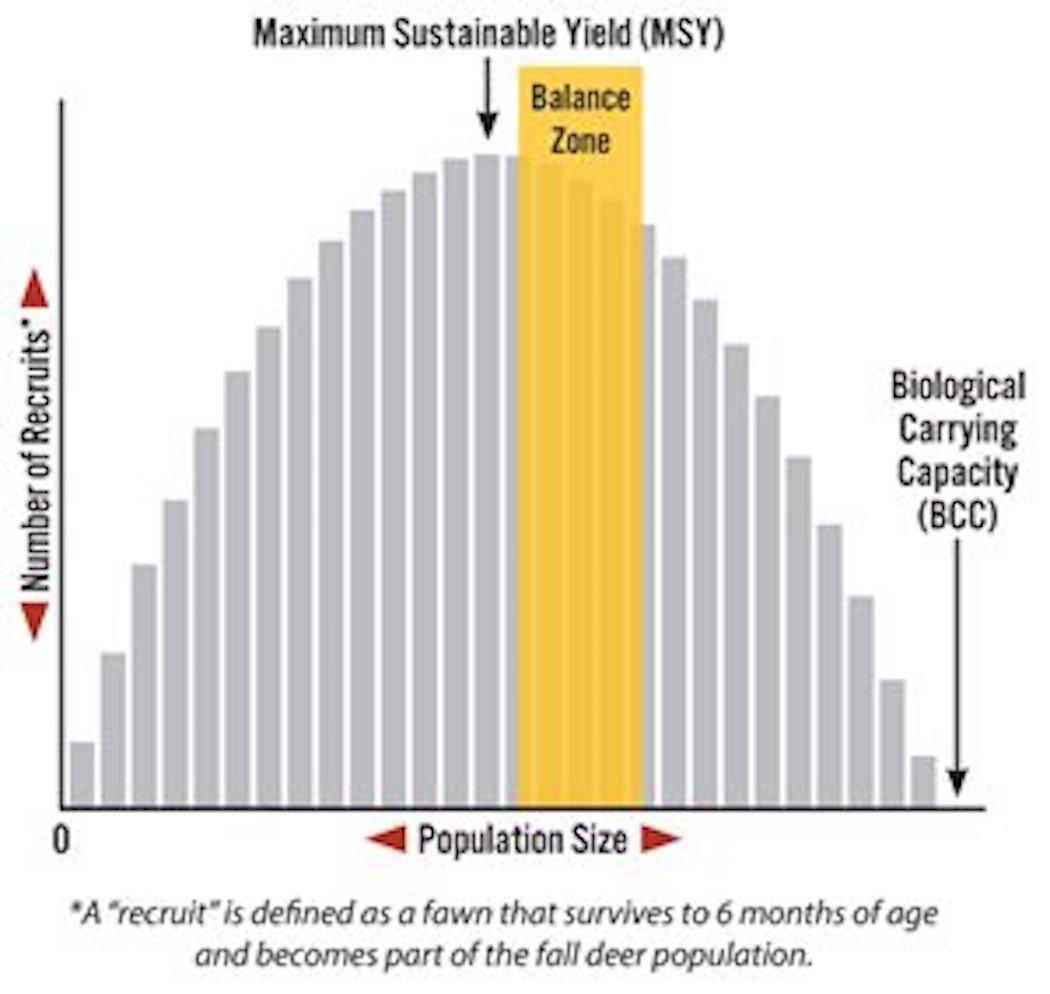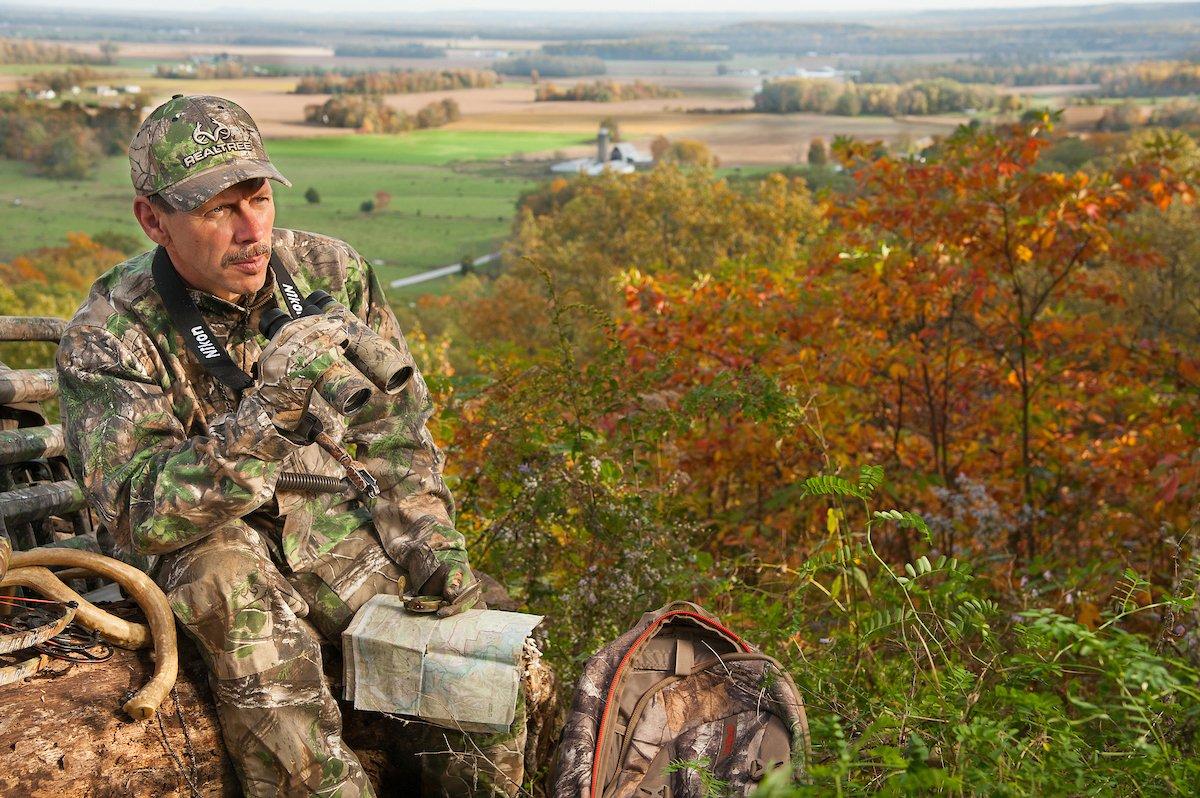Find Out from a Leading Deer Biologist
Carrying capacity is an often-used concept in deer management discussions. Biologists, managers and hunters routinely refer to the carrying capacity of an area, or whether a deer herd is above or below this magical point. However, is the term being used the same by each? What does carrying capacity actually mean?
Carrying capacity is the maximum number of inhabitants an environment can support without detrimental effects. With respect to wildlife populations, a population reaches carrying capacity when productivity is zero: No young are recruited into the population because the density is too high to allow for additional individuals without any detrimental effects to the population or habitat. In reality, populations can and do exceed the carrying capacity on a regular basis. In doing so, they sacrifice their own health as well as damage the vegetation and harm other wildlife species. One reason for the rise in popularity of Quality Deer Management was enough biologists, managers and hunters were fed up with deer herds exhibiting poor health because they were allowed to increase to levels approaching or surpassing an area's carrying capacity. QDMA encourages all deer hunters to manage deer populations at densities lower than this so they are in balance with their habitats. Determining whether a population is below, at, or above carrying capacity, and how to achieve or maintain balance, can be easier said than done, though.
Biological Carrying Capacity
Rather than use a technical definition, let's use a practical one to understand how carrying capacity should play into our management programs. Let's start by separating the term into its most common uses. Biological carrying capacity (BCC) is what I defined above, and an area's BCC is largely determined by the quality and quantity of available habitat. The BCC is the number of deer a given parcel can support in good physical condition over an extended period of time without adversely impacting the habitat. Unfortunately, deer reproductive rates allow populations to exceed BCC unless the number of fawns recruited is balanced by mortality. (Note: A fawn is recruited when it survives to about 6 months of age and enters the fall deer population.)
Don't Miss: Advanced Deer Hunting Information at Your Fingertips
Cultural Carrying Capacity

Don't Miss: Are Even or Odd Points More Common in Deer?
Maximum Sustainable Yield
The accompanying chart depicts the normal growth curve of a deer population. Starting with a low density, the population grows rapidly because there are sufficient resources for the herd, so fawn recruitment is high. This growth continues until the population reaches a density that is approximately half of BCC. This point is referred to as the maximum sustainable yield (MSY), and this is where fawn recruitment is maximized. Therefore, this is the point where the maximum number of bucks is brought into the population. Remember, approximately every other fawn born is a buck fawn, so the way to recruit the most bucks is by recruiting the maximum number of fawns. When the population grows above this density, resources are less abundant for each deer, so the number of fawns recruited into the population declines. This is why fewer, healthier does can produce and recruit more fawns (and thus more bucks). This is also why the old adages, When you kill a doe you're really killing three deer or When you kill a doe you're killing next year's buck are rarely true. They are generally only true if the population is below MSY.
You can harvest more deer on a sustained basis when a population is at MSY than at any other density. You likely aren't seeing as many deer as if the population was at BCC, but the population is much healthier and you're able to harvest a far higher number year after year. For those of you like me, who like to shoot deer, this is the preferred density to manage for, right? Actually it's not. Populations are unstable at MSY, and even slight overharvests reduce the number of recruits and the population. It's much wiser to be just to the right of MSY. In this part of the growth curve, populations are stable, and slight overharvests move the population to MSY (and actually increase fawn recruitment). This position also minimizes disturbance to vegetation, thus allowing for healthy, productive habitats.
Don't Miss: 7 Ways to Practice Quality Deer Management
Balance Zone
A main goal of Quality Deer Management is to balance a deer herd with its habitat. Where does this point occur on the chart? It's actually not a single point. Rather, it is a zone, and it occurs just to the right of MSY.
Where is the deer herd that you hunt in relation to this zone on the figure? You determine this by collecting some habitat, observation and harvest data. Do you have a visible browse line? If so, you're way past where you want to be. Take a walk in the woods and observe whether the understory is regenerating. Next, determine if there are preferred tree species in that understory versus non-preferred species. These assessments help you gauge where you are on the figure. Can't identify tree species? Get a tree field guide and start learning, or have a consulting forester or biologist visit the property. You can also contact your local QDMA Branch to find members who can identify local tree and plant species and help you get started.
Combine your habitat assessment with observation data collected from the archery and/or firearms seasons and harvest data collected from every deer harvested or found dead on the property. By recording the number of does and fawns observed, you can estimate whether the number of recruits is increasing or decreasing. Combine this with harvest data such as weight, lactation status and kidney fat indices and you can determine whether the overall health of the herd is increasing or decreasing.
Don't Miss: 7 Ways to Kill Bigger Deer on Small Properties
X Marks the Spot
The goal isn't to find the exact spot on the figure where a deer herd lies. Rather, initially it is to estimate whether it is to the left or right of MSY. If it's to the left, then I'd suggest allowing the herd to increase. If it's to the right, then determine whether it's between MSY and BCC or past BCC. If it's past BCC, then I'd suggest reducing the herd. If it's between MSY and BCC then you're at a great starting point, but I would continue collecting data and fine tuning the location to suit your goals. If you like to see deer, shoot a lot and don't want to sacrifice herd or habitat health, then you should move the population toward the left side of the balance zone. If you like to see a lot of deer but not shoot as many, and are willing to sacrifice some herd and habitat health, then you can allow the population to move toward the right side of the balance zone. A word of caution if you choose the latter: Keep a close eye on habitat and herd health indicators. Once habitat damage becomes severe, recovery takes time and may only be possible if you reduce the deer population below MSY.
Don't Miss: 6 Things That Attract Big Bucks
Can I Improve?
Many QDM practitioners are interested in increasing the quality of the habitat they hunt. This is a great way to also increase the carrying capacity of an area. In low-productivity habitats, a deer herd in the balance zone may be too low to provide acceptable hunting experiences. In these cases, the best alternative is to improve the habitat. Depending on habitat type, this can be accomplished through timber harvesting, tree and shrub planting, prescribed burning, applying herbicides, disking, roller chopping or fertilizing. Then the area can be supplemented with high-quality food plots. An area with increased food and cover can support more deer and is definitely more attractive to whitetails.
Don't Miss: Managing Native Vegetation Alongside Food Plots for Whitetails
The Take-Home Message
Carrying capacity is a measure of the number of deer an area can support, both biologically and culturally, and its value changes annually, seasonally and across properties. This is one reason some hunters observe many deer while others a mile or so away can see few or none. Rather than trying to determine the exact carrying capacity of the land you hunt, it's much simpler to manage a deer herd to be in balance with the habitat. You do so by monitoring the health of the herd and its habitat, and determining where that specific herd is in relation to the balance zone. This is a simple procedure that requires a few years of habitat, observation and harvest data. The costs are certainly worth the benefits, as a herd managed at this level provides healthy deer, healthy habitats and tremendous hunting opportunities.
Don't Miss: The Ultimate Deer Hunting Property
About the Author: Kip Adams of Pennsylvania is a certified wildlife biologist and QDMA's Director of Education & Outreach in the North.
Editor's Note: This was originally published on October 16, 2009.
Are you a deer hunter wanting to learn how to accomplish your goals? Check out our stories, videos and hard-hitting how-to's on deer hunting.







